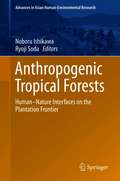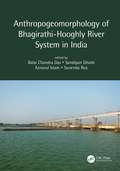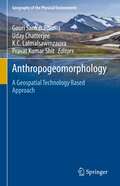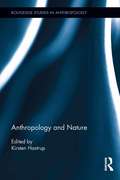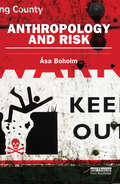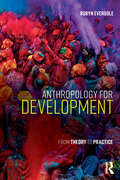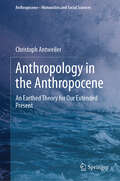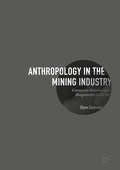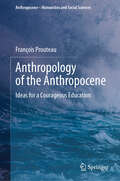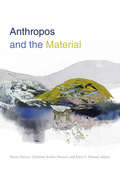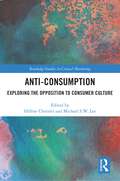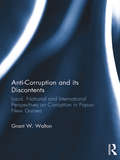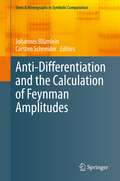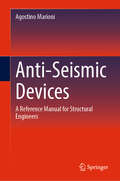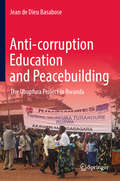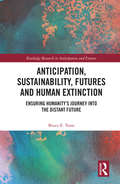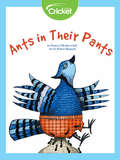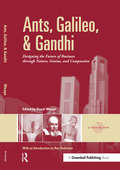- Table View
- List View
Anthropogenic Tropical Forests: Human–Nature Interfaces on the Plantation Frontier (Advances in Asian Human-Environmental Research)
by Noboru Ishikawa Ryoji SodaThe studies in this volume provide an ethnography of a plantation frontier in central Sarawak, Malaysian Borneo. Drawing on the expertise of both natural scientists and social scientists, the key focus is the process of commodification of nature that has turned the local landscape into anthropogenic tropical forests. Analysing the transformation of the space of mixed landscapes and multiethnic communities—driven by trade in forest products, logging and the cultivation of oil palm—the contributors explore the changing nature of the environment, multispecies interactions, and the metabolism between capitalism and nature. The project involved the collaboration of researchers specialising in anthropology, geography, Southeast Asian history, global history, area studies, political ecology, environmental economics, plant ecology, animal ecology, forest ecology, hydrology, ichthyology, geomorphology and life-cycle assessment.Collectively, the transdisciplinary research addresses a number of vital questions. How are material cycles and food webs altered as a result of large-scale land-use change? How have new commodity chains emerged while older ones have disappeared? What changes are associated with such shifts? What are the relationships among these three elements—commodity chains, material cycles and food webs? Attempts to answer these questions led the team to go beyond the dichotomy of society and nature as well as human and non-human. Rather, the research highlights complex relational entanglements of the two worlds, abruptly and forcibly connected by human-induced changes in an emergent and compelling resource frontier in maritime Southeast Asia.
Anthropogeomorphology of Bhagirathi-Hooghly River System in India
by Balai Chandra DasThe Bhagirathi-Hooghly Basin in India is one of the most densely populated regions in the world and is undergoing rapid transformation of its natural landscape induced by human interventions, such as mushrooming of dams and barrages, deforestation, and urbanization. Human activities and interventions on basin landforms and the processes that shape those landforms have accelerated at an alarming rate. This book uses spatio-temporal analysis to understand the major anthropogenic signatures on land use and land cover changes and the impact these activities have on the landforms and processes of the Bhagirathi-Hooghly River and its sub-basins. It answers the what, where, why, and how of the anthropogenic signatures involved. Recent case studies on the impact of anthropogenic signatures on fluvial forms and processes make this book a useful resource for students and researchers in the earth sciences, local governments, urban planners, and all concerned with rural developments. Features: Explores for the first time the new concept of anthropogeomorphology for the river basin—an emerging field Analyses the impact of anthropogenic activities, especially the construction of dams and reservoirs, and urbanization on major fluvial landscapes using advanced geospatial modelling techniques Investigates human interference in river systems, their effects on the dynamics of the river, and the livelihoods of the people residing along the river Addresses issues related to geology, geomorphology, geography, planning, land use, and land management areas Fills the need for data-driven governance and policy decisions for the future of urban-industrial growth in India.
Anthropogeomorphology: A Geospatial Technology Based Approach (Geography of the Physical Environment)
by Gouri Sankar Bhunia Pravat Kumar Shit Uday Chatterjee K. C. LalmalsawmzauvaThis book explores state-of-art techniques based on open-source software and statistical programming and modelling in modern geospatial applications, specifically focusing on recent trends in data mining techniques and robust modelling in Geomorphological, Hydrological, Bio-physical and Social activities. The book is organized into physical, mountainous, coastal, riverine, forest, urban and biological activities, with each chapter providing a review of the current knowledge in the focus area, and evaluating where future efforts should be directed. The text compiles a collection of recent developments and rigorous applications of Geospatial computational intelligence (e.g., artificial neural network, spatial interpolation, physical and environmental modelling and machine learning algorithms etc) in geomorphic processes from a team of expert contributors. The authors address the wide range of challenges and uncertainties in the study of earth system dynamics due to climate change, and complex anthropogenic interferences where spatial modelling may be applied in the risk assessment of vulnerable geomorphological landscapes. The book will act as a guide to find recent advancements in geospatial artificial intelligence techniques and its application to natural and social hazards. This information will be helpful for students, researchers, policy makers, environmentalists, planners involved in natural hazard and disaster management, NGOs, and government organizations.
Anthropology and Nature (Routledge Studies in Anthropology #14)
by Kirsten HastrupOn the basis of empirical studies, this book explores nature as an integral part of the social worlds conventionally studied by anthropologists. The book may be read as a form of scholarly "edgework," resisting institutional divisions and conceptual routines in the interest of exploring new modalities of anthropological knowledge making. The present interest in the natural world is partly a response to large-scale natural disasters and global climate change, and to a keen sense that nature matters matters to society at many levels, ranging from the microbiological and genetic framing of reproduction, over co-species development, to macro-ecological changes of weather and climate. Given that the human footprint is now conspicuous across the entire globe, in the oceans as well as in the atmosphere, it is difficult to claim that nature is what is given and permanent, while people and societies are ephemeral and simply derivative features. This implies that society matters to nature, and some natural scientists look towards the social sciences for an understanding of how people think and how societies work. The book thus opens up a space for new forms of reflection on how natures and societies are generated.
Anthropology and Risk (Earthscan Risk in Society)
by Asa BoholmDrawing on theory from anthropology, sociology, organisation studies and philosophy, this book addresses how the perception, communication and management of risk is shaped by culturally informed and socially embedded knowledge and experience. It provides an account of how interpretations of risk in society are conditioned by knowledge claims and cultural assumptions and by the orientationof actors based on roles, norms, expectations, identities, trust and practical rationality within a lived social world. By focusing on agency, social complexity and the production and interpretation of meaning, the book offers a comprehensive and holistic theoretical perspective on risk, based on empirical case studies and ethnographic enquiry. As a selection of Åsa Boholm’s publications throughout her career, along with a newly written introduction overviewing the field, this book provides a unified perspective on risk as a construct shaped by social and cultural contexts.This collection should be of interest to students and scholars of risk communication, risk management, environmental planning, environmental management and environmental and applied anthropology.
Anthropology for Development: From Theory to Practice
by Robyn EversoleAnthropology for Development: From Theory to Practice connects cross-cultural social theory with the concerns of development policy and practice. It introduces the reader to a set of key ideas from the field of anthropology of development, and shows how these insights can be applied to solve real-world development dilemmas. This single, accessibly written volume clearly explains key concepts from anthropology and draws them into a framework to address some of the important challenges facing development policy and practice in the twenty-first century: poverty, participation, sustainability and innovation. It discusses classic critical and ethnographic texts and more recent anthropological work, using rich case studies across a range of country contexts to provide an introduction to the field not available elsewhere. The examples presented are designed to help development professionals reframe their practice with attention to social and cultural variables as well as understand why mainstream approaches to reducing poverty, raising productivity, delivering social services and grappling with environmental risks often fail. This book will prove invaluable to undergraduate and postgraduate students who are professionals-in-training in development studies programs around the world. It will also help development professionals work effectively and inclusively across cultures, tap into previously invisible resources, and turn current development challenges into opportunities.
Anthropology in the Anthropocene: An Earthed Theory for Our Extended Present (Anthropocene – Humanities and Social Sciences)
by Christoph AntweilerIn this book, anthropologist and geologist Christoph Antweiler shows that geology is a special, namely historical, natural science and is therefore relevant for a historically informed anthropology. He argues that we do not only need a geologically informed cultural anthropology, but conversely also an anthropologically oriented geology. A comprehensive geology must include material human culture as a fundamental geological phenomenon. In relation to cultural anthropology, the author discusses the challenge the Anthropocene poses for cultural anthropology as a traditionally micro-oriented social science. The book discusses where the blind spots lie in the highly interdisciplinary discussion. Common narratives are critically scrutinized. The author argues for the need for a new discipline: geoanthropology.
Anthropology in the Mining Industry: Community Relations after Bougainville's Civil War
by Glynn CochraneThis book outlines how Rio Tinto--one of the world's largest miners--redesigned and rebuilt relationships with communities after the rejection of the company during Bougainville's Civil War. Glynn Cochrane recalls how he and colleagues utilized their training as social anthropologists to help the company to earn an industry leadership reputation and competitive business advantage by establishing the case for long-term, on the ground, smoke-in-the-eyes interaction with people in local communities around the world, despite the appeal of maximal efficiency techniques and quicker, easier answers. Instead of using ready-made, formulaic toolkits, Rio Tinto relied on community practitioners to try to accommodate local preferences and cultural differences. This volume provides a step-by-step account of how mining companies can use social anthropological and ethnographic insights to design ways of working with local communities, especially in times of upheaval.
Anthropology of the Anthropocene: Ideas for a Courageous Education (Anthropocene – Humanities and Social Sciences)
by François ProuteauThis book questions the epistemological foundations of education in the Anthropocene. It reviews a body of evidence that strongly supports the view that the Earth’s systems are emerging into an epoch known as the Anthropocene. This volume examines a number of concepts including the political ecology and the modes of veridiction in the Anthropocene as well as philosophy, anthropology and history of the concept of courage and the humanities. It champions forward-looking educational initiatives and presents a new philosophy on education for the Anthropocene. The concept of the Anthropocene extends to many fields of sciences. It is now anchored in a multidisciplinary scientific literature and recognized by both sides of the ideological and political battle of the 21st century, on which several controversies are grafted in a complex way. It also has a strong anthropological consistency: what kind of humans do we want to become? The author explores how the recognition of the crisis helps to see the history of humanity with unexpected freshness. This work contributes to an epistemological and paradigmatic reflection on the foundations of education in the Anthropocene epoch. The author has seized on the biogeophysical ruptures of the Anthropocene to develop a pedagogical and anthropological reflection in a stimulating and creative way. This volume is of interest to researchers of the Anthropocene, as well as to scholars in ecology, social sciences, pedagogy, and philosophy.
Anthropos and the Material
by Christian Krohn-Hansen Penny Harvey Knut G. NustadThe destructive effects of modern industrial societies have shaped the planet in such profound ways that many argue for the existence of a new geological epoch called the Anthropocene. This claim brings into relief a set of challenges that have deep implications for how relations between the human, the material, and the political affect contemporary social worlds. The contributors to Anthropos and the Material examine these challenges by questioning and complicating long-held understandings of the divide between humans and things. They present ethnographic case studies from across the globe, addressing myriad topics that range from labor, economics, and colonialism to technology, culture, the environment, agency, and diversity. In foregrounding the importance of connecting natural and social histories, the instability and intangibility of the material, and the ways in which the lively encounters between the human and the nonhuman challenge conceptions of liberal humanism, the contributors point to new understandings of the capacities of people and things to act, transform, and adapt to a changing world.
Anti-Consumption: Exploring the Opposition to Consumer Culture (Routledge Studies in Critical Marketing)
by Hélène Cherrier Michael S W LeeIn this edited volume, the leading scholars in the field engage with consumers, marketers, corporations and policymakers as well as space dynamics and network formation to provide an in-depth examination of anti-consumption: a voluntary behavioural inclination to minimise rather than grow, to decelerate and simplify and to reduce the unnecessary exploitation of resources fuelled by consumer culture. This book does not place anti-consumption on the high moral ground but rather demonstrates its complexity to spur innovative and critical thinking on how people, organisations, businesses and governments can treat consumption more as a necessity for survival than as a tool for self-expression, pleasure and economic growth. The first part of this book looks at anti-consumption from a diversity of perspectives. It analyses voluntary simplicity, a self-motivated engagement in consumption reduction, and boycotting, a politically-motivated reaction against unacceptable corporate practices, as distinct manifestations of anti-consumption that nonetheless remain rooted in the logic of the market. Paving the way to critical perspectives on the interface between anti-consumption, people and the environment, the second part of the book projects anti-consumption to issues of waste production and provides possible answers to global challenges of resources depletion, social inequalities and global warming. In this section, anti-consumption is critically assessed as an actor of change, both in terms of social change and paradigm change. To move the field forward, the third part of this book presents several theoretical frameworks that help set a roadmap for future research. Anti-Consumption will be of direct interest to scholars and researchers within the fields of marketing, consumer research, business studies, environmental studies and sustainability. It will also be of value to those researching the economics and/or sociology of markets.
Anti-Corruption and its Discontents: Local, National and International Perspectives on Corruption in Papua New Guinea
by Grant W. WaltonThe fight against corruption is now a core part of development policy and practice. Some call these efforts a ‘war on corruption’. What does this so-called ‘war’ mean for developing countries? And how do international perspectives on corruption relate to local and national concerns? This book examines the relevance of anti-corruption discourse in Papua New Guinea (PNG), one of the most culturally rich and ‘corrupt’ countries on earth. Despite increased international, national and local efforts to address corruption over the past two decades, many fear that levels of corruption continue to rise largely unabated. Some believe that the mismatch between international, national and local assumptions regarding the nature of corruption and how it should be addressed is at the heart of the issue. International anti-corruption initiatives stress ‘zero-tolerance’ and try to strengthen formal state-based institutions. However, many people in PNG are more concerned about maintaining social relationships than following state laws and rules. This book critically examines the implications of the anti-corruption agenda and the collision of international, national and local perspectives. In doing so it provides a diagnostic on international assumptions about corruption and how it should be fought in developing countries, offering surprising and important lessons. This book is essential reading for scholars and students of Development Studies, Geography, Political Studies and Economics, as well as practitioners and policy makers working in development.
Anti-Differentiation and the Calculation of Feynman Amplitudes (Texts & Monographs in Symbolic Computation)
by Carsten Schneider Johannes BlümleinThis volume comprises review papers presented at the Conference on Antidifferentiation and the Calculation of Feynman Amplitudes, held in Zeuthen, Germany, in October 2020, and a few additional invited reviews. The book aims at comprehensive surveys and new innovative results of the analytic integration methods of Feynman integrals in quantum field theory. These methods are closely related to the field of special functions and their function spaces, the theory of differential equations and summation theory. Almost all of these algorithms have a strong basis in computer algebra. The solution of the corresponding problems are connected to the analytic management of large data in the range of Giga- to Terabytes. The methods are widely applicable to quite a series of other branches of mathematics and theoretical physics.
Anti-Seismic Devices: A Reference Manual for Structural Engineers
by Agostino MarioniThis book stands as a manual and ready reference for structural engineers on the seismic protection of civil engineering structures. Beginning with a short historical overview, the book explains the concepts of seismic protection, describes the most common types of anti-seismic devices, and summarizes the main existing standards for anti-seismic devices, with particular reference to the European Standard. It imparts expertise on the devices that is normally restricted by proprietary interests of a few specialists. Then it goes on to illustrate the main differences between European and American Standards, examine the output of the principle laboratories globally engaged in testing anti-seismic devices, and to describe state-of-art technologies to retrofit seismically existing buildings. The volume concludes with a number of accounts of projects involving the author where structures were equipped with anti-seismic devices and provides some insight on the future development of relevant technologies.
Anti-corruption Education and Peacebuilding: The Ubupfura Project in Rwanda
by Jean de BasaboseThis study explores corruption in Rwanda and highlights the necessity of developing anti-corruption education as a way of combating corruption. It argues that an effective campaign against corruption should consider promoting anti-corruption education with the aim of enabling present and future generations to maintain and live out the Ubupfura (meaning "trust/respect") ethical values. Considering the link between anti-corruption and peacebuilding efforts, as explained in this study, it is underlined that continuous efforts to raise such generations could undoubtedly move Rwandan society toward a sustainable peace. Peacebuilders, anti-corruption agents, and public policymakers are the primary beneficiaries of the study.
Anticipation, Sustainability, Futures and Human Extinction: Ensuring Humanity’s Journey into The Distant Future (Routledge Research in Anticipation and Futures)
by Bruce E. TonnThis book considers the philosophical underpinnings, policy foundations, institutional innovations, and deep cultural changes needed to ensure that humanity has the best chance of surviving and flourishing into the very distant future. Anticipation of threats to the sustainability of human civilization needs to encompass time periods that span not just decades but millennia. All existential risks need to be jointly assessed, as opposed to addressing risks such as climate change and pandemics separately. Exploring the potential events that are likely to cause the biggest risks as well as asking why we should even desire to thrive into the distant future, this work looks at the ‘biggest picture possible’ in order to argue that futures-oriented decision-making ought to be a permanent aspect of human society and futures-oriented policy making must take precedent over the day-to-day policy making of current generations in times of great peril. The book concludes with a discourse on the truly fundamental bottom-up changes needed in our personal psychologies and culture to support these top-down recommendations. This book is of great interest to philosophers, policy analysts, political scientists, economists, psychologists, planners, and theologians.
Ants in Their Pants
by Patricia Nikolina ClarkIf you accidentally sat on an anthill, and little black ants started to crawl all over you, would you stay there? Of course not!
Ants, Galileo, and Gandhi: Designing the Future of Business through Nature, Genius, and Compassion
by Sissel WaageAlthough sustainability efforts in business are still a work in progress, it is increasingly clear that key elements of a new generation of enterprises will be radically different from those of our contemporary modern industrial economy. The core distinctions between what currently exists and what is being created are communicated in this book through the compelling metaphor of Ants, Galileo, and Gandhi.This collection, developed from The Natural Step's conference on Sustainability and Innovation in 2002, provides radical ideas for generating a new perspective on the dynamics of business systems. "Ants" symbolise the lessons to be learned from nature and the dependence of individual beings on broader, complex systems. "Galileo" embodies brilliance in perceiving and proving that the current paradigm is flawed. 'Gandhi' exemplifies exceptional compassion in fighting for fundamental change.All of these attributes are increasingly relevant in a world where, globally, we are experiencing both a steady decline in life-supporting resources and rising demands. Recognition of these challenges is sparking innovation within the private sector where the first glimmers of systemic change can be seen. The book examines the emergence of 21st-century enterprises that recognise their reliance on broad social and ecological systems ("ants"), incorporate sparks of genius rooted in rigorous analyses ("Galileo"), and acknowledge the importance of compassion and determination within any endeavour ("Gandhi").With contributions from Ray Anderson, Gretchen Daily, Karl-Henrik Rob
Anxious Geographies: Worlds of Social Anxiety (ISSN)
by Louise E. BoyleAnxious Geographies offers a unique perspective on social anxiety, framing it as both a social and spatial phenomenon. Through a meticulous exploration using online questionnaires and interviews, the book provides a crucial examination of the intricacies of anxious lives.This book presents a critical intervention in the experience of mental health in 21st-century society and provides a compelling geographical account of the underpinnings of the anxious experience. The book pivots on the in-depth perspectives of people with social anxiety, diagnosed or “sub-clinical”, but with an academic commentary that relates their experience to the medicalisation of a disrupted relational life, offering lessons for all of us in modern societies. Each chapter considers a unique aspect of social anxiety accounting for the social, spatial, temporal, relational and embodied dynamics, a geographical approach that enriches our understanding of the contexts and conditions that exacerbate and sustain anxious distress. The phenomenological descriptions herein, capture how social anxiety can profoundly alter a person’s coherent, habitual and embodied sense of being in and navigating through their social and spatial worlds. Through the experiential accounts of anxious distress and by considering the social contexts in which they emerge, this book provides readers with crucial insights into the hidden lives of those living with social anxiety.This book will be of appeal to academics, researchers and postgraduate students in the fields of human geography and across the social sciences and humanities. It will also provide useful insights for academics and health professionals in social psychiatry, social psychology, counselling studies and therapeutic practice.
Anxious Politics
by Bethany Albertson Gadarian Shana KushnerEmotions matter in politics - enthusiastic supporters return politicians to office, angry citizens march in the streets, a fearful public demands protection from the government. Anxious Politics explores the emotional life of politics, with particular emphasis on how political anxieties affect public life. When the world is scary, when politics is passionate, when the citizenry is anxious, does this politics resemble politics under more serene conditions? If politicians use threatening appeals to persuade citizens, how does the public respond? Anxious Politics argues that political anxiety triggers engagement in politics in ways that are potentially both promising and damaging for democracy. Using four substantive policy areas (public health, immigration, terrorism, and climate change), the book seeks to demonstrate that anxiety affects how we consume political news, who we trust, and what politics we support. Anxiety about politics triggers coping strategies in the political world, where these strategies are often shaped by partisan agendas.
Aphids Unveiled: The Saga of Nature's Most Irritating Insects
by Amanda Rose NewtonAphids Unveiled: The Saga of Nature's Most Irritating Insects explores the curious journey of these tiny insects from humble beginnings to becoming the most obnoxious pests for farmers and home gardeners alike. With a witty narrative style and a touch of humor, the book aims to engage readers with the quirky behaviors, social structures, and survival strategies of aphids, all while unraveling the reasons behind their impact on agriculture and horticulture.Amanda Rose Newton brings over a decade of experience in both the horticulture and pest control worlds to write for a broad audience, from gardening enthusiasts seeking effective pest management strategies to science enthusiasts interested in a lighthearted exploration of the natural world. As an entomologist and professor, her writing uniquely blends expertise with a passion for storytelling, ensuring Aphids Unveiled is not only informative but also an entertaining read.
Apocalypse Never: Why Environmental Alarmism Hurts Us All
by Michael ShellenbergerClimate change is real but it’s not the end of the world. It is not even our most serious environmental problem. Michael Shellenberger has been fighting for a greener planet for decades. He helped save the world’s last unprotected redwoods. He co-created the predecessor to today’s Green New Deal. And he led a successful effort by climate scientists and activists to keep nuclear plants operating, preventing a spike of emissions.But in 2019, as some claimed “billions of people are going to die,” contributing to rising anxiety, including among adolescents, Shellenberger decided that, as a lifelong environmental activist, leading energy expert, and father of a teenage daughter, he needed to speak out to separate science from fiction.Despite decades of news media attention, many remain ignorant of basic facts. Carbon emissions peaked and have been declining in most developed nations for over a decade. Deaths from extreme weather, even in poor nations, declined 80 percent over the last four decades. And the risk of Earth warming to very high temperatures is increasingly unlikely thanks to slowing population growth and abundant natural gas. Curiously, the people who are the most alarmist about the problems also tend to oppose the obvious solutions. What’s really behind the rise of apocalyptic environmentalism? There are powerful financial interests. There are desires for status and power. But most of all there is a desire among supposedly secular people for transcendence. This spiritual impulse can be natural and healthy. But in preaching fear without love, and guilt without redemption, the new religion is failing to satisfy our deepest psychological and existential needs.
Apocalypse: Earthquakes, Archaeology, and the Wrath of God
by Amos Nur Dawn BurgessWhat if Troy was not destroyed in the epic battle immortalized by Homer? What if many legendary cities of the ancient world did not meet their ends through war and conquest as archaeologists and historians believe, but in fact were laid waste by a force of nature so catastrophic that religions and legends describe it as the wrath of god? Apocalypse brings the latest scientific evidence to bear on biblical accounts, mythology, and the archaeological record to explore how ancient and modern earthquakes have shaped history--and, for some civilizations, seemingly heralded the end of the world. Archaeologists are trained to seek human causes behind the ruins they study. Because of this, the subtle clues that indicate earthquake damage are often overlooked or even ignored. Amos Nur bridges the gap that for too long has separated archaeology and seismology. He examines tantalizing evidence of earthquakes at some of the world's most famous archaeological sites in the Mediterranean and elsewhere, including Troy, Jericho, Knossos, Mycenae, Armageddon, Teotihuacán, and Petra. He reveals what the Bible, the Iliad, and other writings can tell us about the seismic calamities that may have rocked the ancient world. He even explores how earthquakes may have helped preserve the Dead Sea Scrolls. As Nur shows, recognizing earthquake damage in the shifted foundations and toppled arches of historic ruins is vital today because the scientific record of world earthquake risks is still incomplete. Apocalypse explains where and why ancient earthquakes struck--and could strike again.
Apocalyptic Planet
by Craig ChildsThe earth has died many times, and it always comes back looking different. In an exhilarating, surprising exploration of our planet, Craig Childs takes readers on a firsthand journey through apocalypse, touching the truth behind the speculation. Apocalyptic Planet is a combination of science and adventure that reveals the ways in which our world is constantly moving toward its end and how we can change our place within the cycles and episodes that rule it. In this riveting narrative, Childs makes clear that ours is not a stable planet, that it is prone to sudden, violent natural disasters and extremes of climate. Alternate futures, many not so pretty, are constantly waiting in the wings. Childs refutes the idea of an apocalyptic end to the earth and finds clues to its more inevitable end in some of the most physically challenging places on the globe. He travels from the deserts of Chile, the driest in the world, to the genetic wasteland of central Iowa to the site of the drowned land bridge of the Bering Sea, uncovering the micro-cataclysms that predict the macro: forthcoming ice ages, super-volcanoes, and the conclusion of planetary life cycles. Childs delivers a sensual feast in his descriptions of the natural world and a bounty of unequivocal science that provides us with an unprecedented understanding of our future.
Apollo 13: A Successful Failure
by Laura B. Edge"Houston, we've had a problem." On April 13, 1970, the three astronauts aboard the Apollo 13 spacecraft were headed to the moon when a sudden explosion rocked the ship. Oxygen levels began depleting rapidly. Electrical power began to fail. Astronauts James Lovell, Jack Swigert, and Fred Haise were about to be stranded in the inky void of outer space. The mission to the moon was scrapped. Now, Apollo 13's only goal was to bring the crew home. With the damaged spacecraft hurtling towards the moon at roughly six thousand miles per hour, there was little hope of success. But the astronauts and mission control were fully prepared to do whatever it took to return the crew to Earth. This space disaster occurred at the peak of the United States' Space Race against the Soviet Union. But for four days in 1970, the two nations put aside their differences, and the entire world watched the skies, hoping and praying the astronauts would return safely. As missions to Mars and commercial space flight become a reality, the time is now to be reminded of our common humanity, of how rivals can work together and support each other towards a shared goal. Because no matter what happens or where we travel, we all call Earth home.
